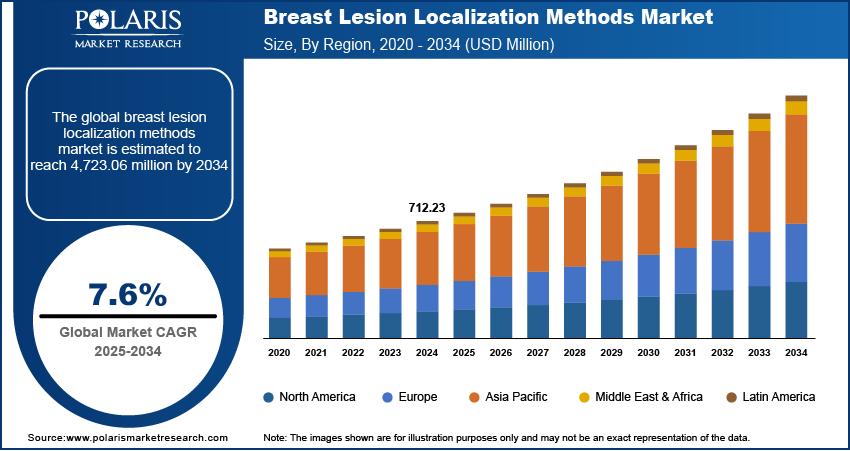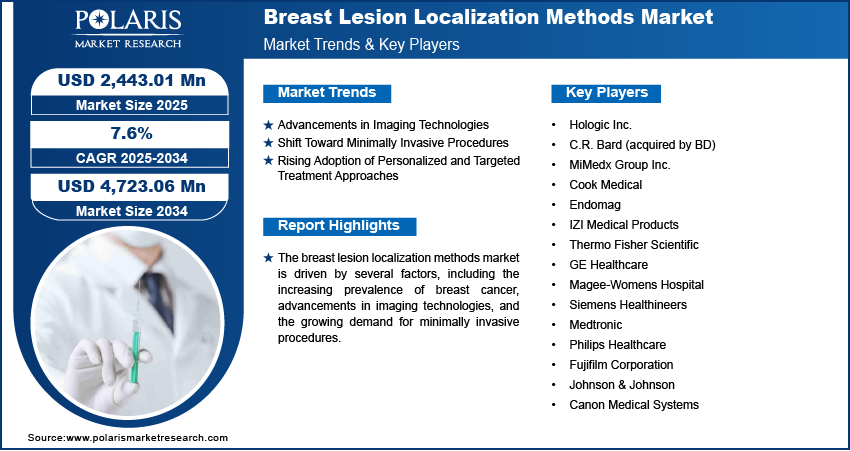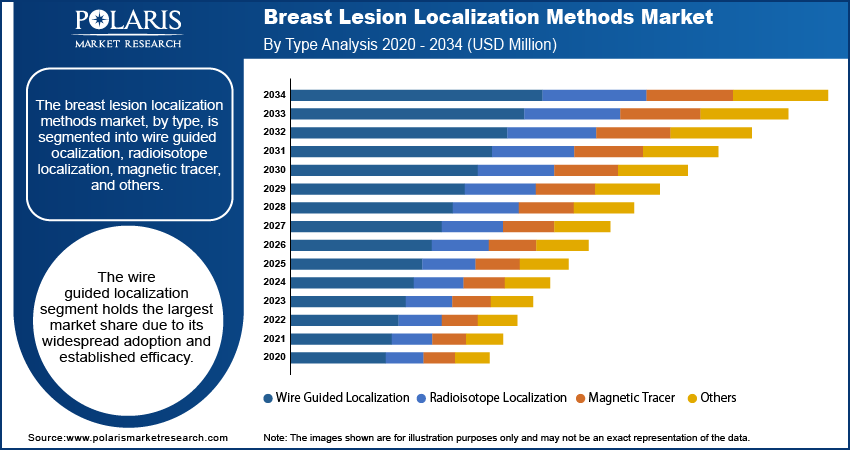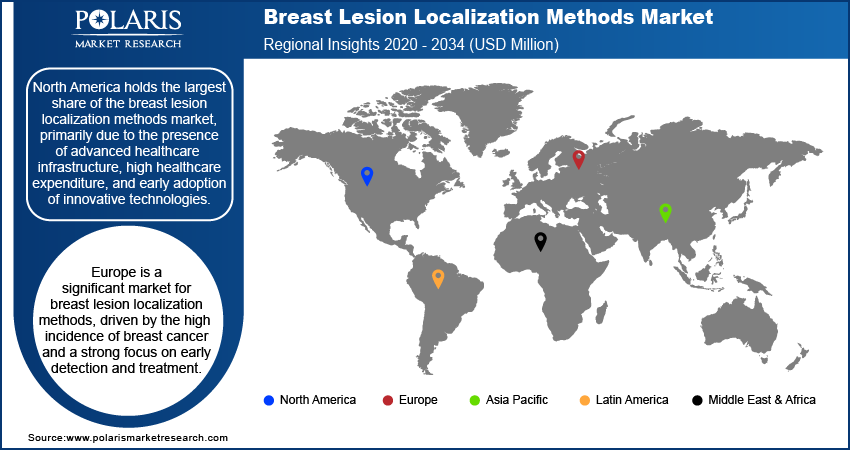
Breast Lesion Localization Methods Market Size, Share, Trends, Industry Analysis Report: By Type (Wire Guided Localization, Radioisotope Localization, Magnetic Tracer, and Others) and Region (North America, Europe, Asia Pacific, Latin America, and Middle East & Africa) – Market Forecast, 2025–2034
- Published Date:Feb-2025
- Pages: 119
- Format: PDF
- Report ID: PM1337
- Base Year: 2024
- Historical Data: 2020-2023
Breast Lesion Localization Methods Market Overview
The global breast lesion localization methods market size was valued at USD 2,281.05 million in 2024. The market is projected to grow from USD 2,443.01 million in 2025 to USD 4,723.06 million by 2034, exhibiting a CAGR of 7.6% from 2025 to 2034.
The breast lesion localization methods market refers to the technologies and procedures used to identify and locate breast lesions during diagnostic imaging or surgery. These methods aid in the accurate detection and treatment of breast cancer.
The increasing prevalence of breast cancer globally, advancements in imaging technologies, and rising awareness of early detection are a few of the key factors driving the breast lesion localization methods market growth. Additionally, the shift toward minimally invasive procedures, such as needle localization and radioactive seed localization, is contributing to the market expansion. The demand for improved accuracy and patient comfort during diagnostic and surgical procedures further supports the adoption of innovative localization techniques.

To Understand More About this Research: Request a Free Sample Report
Breast Lesion Localization Methods Market Dynamics
Advancements in Imaging Technologies
Advanced imaging modalities, such as 3D mammography, ultrasound, and MRI, are increasingly being used for more precise localization of breast lesions. These technologies offer higher resolution images, enabling better visualization of abnormal tissue. For example, 3D mammography (tomosynthesis) has been shown to improve the detection rate of invasive breast cancers compared to standard 2D mammography. According to a study published in Radiology in 2019, 3D mammography can reduce false positives and increase cancer detection by up to 40%. As imaging capabilities improve, there is a growing focus on integrating these advanced techniques into localization procedures, improving accuracy and outcomes. Thus, the continuous advancements in imaging technologies are driving the breast lesion localization methods market development.
Shift Toward Minimally Invasive Procedures
Minimally invasive procedures are being increasingly preferred in the localization of breast lesions, reflecting a broader trend toward less invasive treatments across healthcare. Techniques such as wire-guided localization, radioactive seed localization, and magnetic seed localization are becoming more common, as they offer advantages over traditional open surgery. These methods minimize patient discomfort, reduce recovery times, and lower the risk of complications. For instance, radioactive seed localization (RSL) has been gaining attention due to its precision and ability to provide continuous localization throughout the surgery, improving overall surgical outcomes. Studies have shown that RSL offers similar or even superior accuracy compared to wire-guided methods, with fewer complications related to wire dislodgement.
Rising Adoption of Personalized and Targeted Treatment Approaches
Physicians are now adopting tailored approaches based on the specific characteristics of the patient’s condition, such as the size, location, and type of lesion. This approach not only improves the accuracy of lesion localization but also contributes to more precise treatment planning. Personalized strategies include the use of biopsy markers and the integration of genetic profiling, which provides more detailed information about the tumor. According to The Journal of Clinical Investigation, targeting specific biomarkers has been linked to improved clinical outcomes in breast cancer treatment. As precision medicine continues to evolve, it is likely to further drive the adoption of customized lesion localization methods in clinical settings. This, in turn, is expected to boost the breast lesion localization methods market revenue.

Breast Lesion Localization Methods Market Segment Insights
Breast Lesion Localization Methods Market Evaluation – Type-Based Insights
The breast lesion localization methods market, by type, is segmented into wire guided localization, radioisotope localization, magnetic tracer, and others. The wire guided localization segment holds the largest market share due to its widespread adoption and established efficacy. This method involves the insertion of a wire into the breast to mark the location of a lesion for surgical removal. Despite the growing preference for alternative techniques, wire-guided localization continues to be used in many hospitals and clinics, as it is well-understood and offers reliable results. The radioisotope localization segment is registering the fastest growth, driven by the increasing shift toward minimally invasive techniques and the advantages of precise lesion localization provided by radioactive seed placement. The radioactive seeds provide continuous localization throughout the surgical procedure, which improves surgical outcomes and patient comfort, contributing to its growing popularity.
Other emerging methods, such as magnetic tracer localization, are seeing gradual adoption due to their potential to provide better accuracy and avoid radiation exposure associated with traditional methods. This segment, while smaller in comparison, is expected to grow steadily, particularly in regions where there is increasing focus on reducing radiation risks. The others segment, which includes technologies such as ultrasound-guided localization and other advanced techniques, is also expanding but at a slower pace than radioisotope and magnetic tracer methods. The overall market dynamics indicate a gradual shift towards newer, more precise localization methods, with a steady demand for traditional techniques that ensure reliability in clinical practice.

Breast Lesion Localization Methods Market Regional Analysis
By region, the study provides the breast lesion localization methods market insights into North America, Europe, Asia Pacific, Latin America, and the Middle East & Africa. North America holds the largest share of the global market, primarily due to the presence of advanced healthcare infrastructure, high healthcare expenditure, and early adoption of innovative technologies. The region benefits from a well-established healthcare system with widespread access to advanced diagnostic and surgical tools, driving the demand for accurate and minimally invasive localization techniques. Additionally, the rising prevalence of breast cancer, coupled with increased awareness about early detection, propels the adoption of advanced breast lesion localization methods in North America. The US leads the market in this region, supported by ongoing research and development in imaging technologies and the growing trend toward personalized treatment approaches.
Europe is a significant market for breast lesion localization methods, driven by the high incidence of breast cancer and a strong focus on early detection and treatment. Countries such as Germany, France, and the UK are leading the adoption of advanced localization methods due to their well-established healthcare systems and high levels of healthcare spending. The growing emphasis on personalized and minimally invasive treatments further contributes to the demand for innovative localization technologies. Additionally, regulatory support and government initiatives aimed at improving cancer care infrastructure are boosting market growth in the region. However, the market in Eastern Europe remains relatively underdeveloped compared to Western Europe, primarily due to lower healthcare investment.
The Asia Pacific breast lesion localization methods market is experiencing rapid growth, driven by the increasing prevalence of breast cancer and advancements in healthcare infrastructure. Countries such as China, Japan, and India are witnessing rising adoption of advanced diagnostic techniques, with growing awareness of breast cancer detection. The region's expanding middle class, improved access to healthcare services, and governmental initiatives focused on cancer care are contributing to this market expansion. While Japan and South Korea lead the region in terms of market share, India and China are expected to show the highest growth potential due to their large patient populations and improving healthcare systems. However, the market in developing nations within the region faces challenges related to affordability and access to advanced technology.

Breast Lesion Localization Methods Market – Key Players and Competitive Insights
Key players in the breast lesion localization methods market include Hologic Inc., C.R. Bard (acquired by BD), MiMedx Group Inc., and Cook Medical, which offer a range of localization technologies, such as wire-guided and radioisotope methods. Other significant contributors are Endomag, which specializes in magnetic seed localization, and IZI Medical Products, a supplier of localization products for breast cancer surgery. Additionally, companies like Thermo Fisher Scientific and GE Healthcare focus on enhancing imaging and diagnostic technologies that complement localization procedures. Other players such as Magee-Womens Hospital, Siemens Healthineers, and Medtronic are also involved in the development and commercialization of localization solutions. These companies, along with smaller specialized firms, provide a diverse range of technologies aimed at improving breast cancer diagnosis and surgery.
The competitive landscape in the breast lesion localization methods market is shaped by both large corporations and specialized medical device companies. Companies with a broad portfolio, like Hologic Inc. and GE Healthcare, benefit from their established market presence and ability to offer integrated diagnostic and localization solutions. Meanwhile, smaller companies such as Endomag and IZI Medical focus on innovating specific technologies like magnetic seed and radioactive seed localization, which are gaining traction due to their accuracy and minimal invasiveness. The market also shows increasing collaboration between device manufacturers and healthcare providers, which helps to expand the adoption of these methods in both developed and emerging markets.
In terms of competitive dynamics, product innovation plays a key role in differentiating companies within the market. As demand shifts towards minimally invasive procedures, players are investing in developing technologies that reduce radiation exposure and improve accuracy. Moreover, increasing awareness about early detection of breast cancer and growing emphasis on patient comfort are driving companies to refine their products. Companies that can deliver advanced, cost-effective solutions while meeting regulatory standards are likely to gain an advantage in this market. Given the rising focus on personalized medicine, those who can integrate localization methods with genetic testing or advanced imaging may also position themselves for success.
Hologic Inc. is a prominent player in the breast lesion localization methods market, known for its comprehensive approach to breast cancer detection and treatment. The company offers a variety of localization techniques, including wire-guided and radioactive seed methods. Hologic has a strong presence in North America and Europe, where its products are widely used in breast cancer surgeries.
GE Healthcare is another significant player, providing imaging solutions that complement breast lesion localization techniques. The company has been focusing on improving its imaging technologies, including mammography and MRI systems, to aid in the precise detection and localization of breast lesions.
List of Key Companies in Breast Lesion Localization Methods Market
- Hologic Inc.
- C.R. Bard (acquired by BD)
- MiMedx Group Inc.
- Cook Medical
- Endomag
- IZI Medical Products
- Thermo Fisher Scientific
- GE Healthcare
- Magee-Womens Hospital
- Siemens Healthineers
- Medtronic
- Philips Healthcare
- Fujifilm Corporation
- Johnson & Johnson
- Canon Medical Systems
Breast Lesion Localization Methods Industry Developments
- In October 2024, Hologic announced that it received FDA approval for an advanced version of its 3D mammography system, which aims to enhance the accuracy of breast lesion detection. This approval underscores the company's ongoing commitment to improving diagnostic tools.
- In October 2023, GE Healthcare launched an AI-powered tool designed to enhance breast cancer detection, aiming to support clinicians in making more accurate decisions. This development is part of the company's broader strategy to integrate artificial intelligence with medical imaging for better patient outcomes.
Breast Lesion Localization Methods Market Segmentation
By Type Outlook
- Wire Guided Localization
- Radioisotope Localization
- Magnetic Tracer
- Others
By Regional Outlook
- North America
- US
- Canada
- Europe
- Germany
- France
- UK
- Italy
- Spain
- Netherlands
- Russia
- Rest of Europe
- Asia Pacific
- China
- Japan
- India
- Malaysia
- South Korea
- Indonesia
- Australia
- Vietnam
- Rest of Asia Pacific
- Middle East & Africa
- Saudi Arabia
- UAE
- Israel
- South Africa
- Rest of Middle East & Africa
- Latin America
- Mexico
- Brazil
- Argentina
- Rest of Latin America
Breast Lesion Localization Methods Market Report Scope
|
Report Attributes |
Details |
|
Market Size Value in 2024 |
USD 2,281.05 million |
|
Market Size Value in 2025 |
USD 2,443.01 million |
|
Revenue Forecast by 2034 |
USD 4,723.06 million |
|
CAGR |
7.6% from 2025 to 2034 |
|
Base Year |
2024 |
|
Historical Data |
2020–2023 |
|
Forecast Period |
2025–2034 |
|
Quantitative Units |
Revenue in USD million and CAGR from 2025 to 2034 |
|
Report Coverage |
Revenue Forecast, Market Competitive Landscape, Growth Factors, and Trends |
|
Segments Covered |
|
|
Regional Scope |
|
|
Competitive landscape |
|
|
Report Format |
|
|
Customization |
Report customization as per your requirements with respect to countries, regions, and segmentation. |
How is the report valuable for an organization?
Workflow/Innovation Strategy: The breast lesion localization methods market has been segmented into detailed segments of type. Moreover, the study provides the reader with a detailed understanding of the different segments at both the global and regional levels.
Growth/Marketing Strategy: The growth strategy for the breast lesion localization methods market is focused on product innovation, particularly the development of minimally invasive and accurate localization techniques. Companies are increasingly investing in advanced imaging technologies, such as 3D mammography and AI-powered diagnostic tools, to enhance precision. Strategic partnerships with healthcare providers and collaborations with research institutions are also being pursued to expand market reach. Additionally, players are targeting emerging markets in Asia Pacific and Latin America, where healthcare infrastructure is improving and awareness of breast cancer detection is rising. Companies are also emphasizing cost-effective solutions to cater to a broader range of healthcare settings.
FAQ's
The breast lesion localization methods market size was valued at USD 2,281.05 million in 2024 and is projected to grow to USD 4,723.06 million by 2034.
The market is projected to register a CAGR of 7.6% from 2025 to 2034.
North America had the largest share of the market in 2024.
A few of the key players in the breast lesion localization methods market include Hologic Inc., C.R. Bard (acquired by BD), MiMedx Group Inc., and Cook Medical, which offer a range of localization technologies, such as wire-guided and radioisotope methods. Other significant contributors are Endomag, which specializes in magnetic seed localization, and IZI Medical Products, a supplier of localization products for breast cancer surgery.
The wire guided localization segment accounted for the largest share of the market in 2024.
Breast lesion localization methods refer to various techniques used to accurately identify and mark the location of abnormal tissue or lesions in the breast, typically for diagnostic or surgical purposes. These methods are critical in breast cancer detection and treatment, as they guide surgeons during procedures such as tumor removal or biopsy. Common localization techniques include wire-guided localization, where a wire is inserted into the breast to mark the lesion; radioactive seed localization, where a small radioactive seed is placed near the lesion; and magnetic tracer localization, which uses magnetic markers for precise identification. These methods help ensure that surgeons can remove or examine the targeted tissue with high accuracy, improving patient outcomes.
A few key trends in the breast lesion localization methods market are described below: Advancements in Imaging Technologies: Integration of 3D mammography, MRI, and AI-powered imaging tools are enhancing the accuracy and precision of breast lesion localization. Shift Toward Minimally Invasive Techniques: Growing preference for methods like radioactive seed and magnetic tracer localization, which offer better patient comfort and reduce recovery times. Personalized Treatment Approaches: Increasing adoption of tailored localization methods based on patient-specific factors, integrating genetic profiling and advanced diagnostic tools. Expansion in Emerging Markets: Rising awareness about early detection of breast cancer and improving healthcare infrastructure in Asia Pacific and Latin America.
A new company entering the breast lesion localization methods market could focus on developing advanced, minimally invasive techniques that prioritize patient comfort and reduce recovery times, as this is a growing trend. Investing in technologies that integrate artificial intelligence and machine learning with imaging tools could enhance diagnostic accuracy and streamline procedures. Additionally, offering cost-effective solutions for emerging markets, where healthcare infrastructure is rapidly improving, would be a strategic approach. Focusing on partnerships with hospitals and clinics to ensure widespread adoption and creating innovative training programs for healthcare professionals could further differentiate the company in the competitive landscape.
Companies manufacturing, distributing, or purchasing breast lesion localization methods and related products, and other consulting firms must buy the report.
